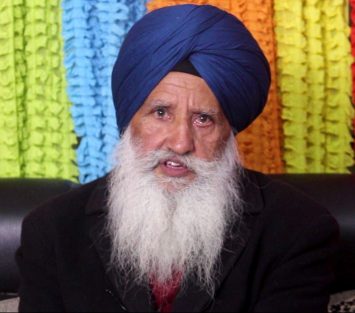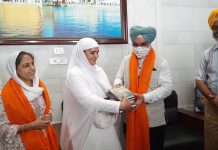SRI GANGANAGAR, Rajasthan, India—S. Hardeep Singh Dibdiba who at one time had served as personal assistant to former Akal Takht Jathedar Bhai Jasbir Singh Rode, is testament to the political developments that occurred in the Sikh community after the June 1984 holocaust. He was part of the core team which begun efforts to unite whole Sikh community under the leadership of Baba Joginder Singh Rode (father of Sant Jarnail Singh Ji Khalsa Bhindranwale) after June 1984.
S. Dibdiba has penned a book named “ਸਾਕਾ ਨੀਲਾ ਤਾਰਾ ਤੋਂ ਬਾਅਦ – ਤਬਾਹੀ ਦੀ ਤਵਾਰੀਖ਼” elaborating the circumstances of post-1984 era and how the dominance of nepotism over Sikh ideology ultimately caused the collapse of struggle for a sovereign Sikh state.
Sikh24 interviewed S. Hardeep Singh to know about his valuable experiences in the Sikh struggle. A brief part of his conversation with Sikh24 is being presented here for our audience.



Question: How did you become a part of the Sikh struggle?
Answer: Like every common Sikh I was also a keen observer of the Dharam Yudh Morcha during my young age. Indian army’s invasion into the sanctum sanctorum Sri Harmandir Sahib and demolition of the supreme Sikh throne Sri Akal Takht Sahib in June 1984 twitched my soul.
May be on June 17 or 18, I along with my childhood friend Amolak Singh (grandson of Sant Giani Gurbachan Singh Ji Khalsa Bhindranwale) reached Sri Harmandir Sahib to take stock of the situation. I saw every Sikh mourning while watching the aftermath of devastation committed by the Indian army and this scenario also shook me inside.
Every Sikh at that time used to get keen to see village of Sant Jarnail Singh Ji Khalsa Bhindranwale. Similarly, we also reached village Rode and met Baba Joginder Singh Rode. Amolak Singh’s background and my proximity with Amolak Singh became reason for both of us to become a part of Sikh struggle of June-1984’s holocaust.
Question: How did you get active in the Sikh struggle during that time?
Answer: On the directions of Baba Joginder Singh Rode we met S. Jagjit Singh Rode (brother of Sant Jarnail Singh Ji Khalsa Bhindranwale) in jail and he inspired us to take political initiatives to erect movement for Sikh rights in Punjab. Actually, a vacuum was being observed during those days as all the political Sikh leaders were put behind bars by the Indian government.
During this time, we begun efforts to unite the entire Sikh leadership onto a common platform. Ultimately, a decision was taken to form United Akali Dal under the patronage of Baba Joginder Singh Rode.
Question: How did United Akali Dal came to existence?
Answer: Baba Joginder Singh Rode had emerged as a trustworthy personality for Sikhs during this environment of unreliability when the injured Sikh psyche was not ready to accept the customary Akali leadership for leading on Sikh issues.
As soon as the customary Akali leaders like Harchand Singh Longowal, Jagdev Singh Talwandi and others started coming out of jails, they steadily observed the adverse circumstances for them and thought it in their favour to work under shadow of Baba Joginder Singh Rode.
Firstly, Harchand Singh Longowal paid visit to Baba Joginder Singh Rode and gave him in written that he would abide by his orders in interest of the Sikh community.
Similarly, Jagdev Singh Talwandi also gave consent in written to Baba Joginder Singh Rode but he kept condition that he won’t accept Harchand Singh Longowal as president.
In this way, a nine-member executive committee of United Akali Dal was initially constituted under leadership of Baba Joginder Singh Rode.
Question: What did this UAD’s executive committee got split within 24 hours?
Answer: Initially, objections were raised on the appointment of Advocate Inderjit Singh Sekhon as general secretary of United Akali Dal as Sekhon was nearby of Giani Zail Singh who had permitted the then Indian PM Indira Gandhi to commit holocaust of June-1984. But Sekhon immediately resigned as soon as he got apprised of objections over his appointment.
Amid this, activists of Longowal faction also started demanding presidency of UAD for Longowal by saying that he was a dictator of Dharam Yudh Morcha. As Baba Joginder Singh Rode had already appointed Simranjit Singh Mann as UAD’s President and further Talwandi had also kept condition of not appointing Longowal as President, so he refused to do so which ultimately cause dissolving of this nine member executive committee with 24 hours.
Later, this nine member executive committee was once again reorganized and it served onto its motto.
Question: Why the AISSF leaders were not in favour of constitution of UAD?
Answer: The leaders of All India Sikh Students Federation were of the view that there was no need of constituting United Akali Dal as Sant Jarnail Singh Ji Khalsa Bhindranwale had approved the AISSF as political wing of Sikhs and the AISSF should be given command to lead the Sikh struggle. But Baba Joginder Singh Rode didn’t bow to AISSF’s claims and said that the Akali Dal has been a traditional political wing of Sikh community so now Akali Dal will be leading the Sikh struggle.
Question: United Akali Dal had called for boycott of 1985’s assembly elections in Punjab but still Barnala led faction of Akali Dal succeeded in forming government of Punjab. Why it was so?
Answer: See, common masses of Punjab were in panic after the 1984’s holocaust and also a majority of Punjab youth was put behind bars. After murder of Harchand Singh Longowal, reins of Longowal’s faction came in hands of Surjit Singh Barnala and he projected the release of detained Punjab masses from jails as his primary preference in the election manifesto.
Although, the United Akali Dal’s conferences were also observing a massive mass support but still people voted for Barnala which could be seen as families’ preferences to their children than Sikh cause.
Question: How did you get appointed as personal assistant of Bhai Jasbir Singh Rode?
Answer: When Bhai Jasbir Singh Rode came out of jail in 1987, I was in Uttar Pradesh as I was given the reins of United Akali Dal’s Uttar Pradesh unit. I went to Sri Harmandir Sahib on the day when Bhai Jasbir Singh Rode was officially announced as Jathedar of Sri Akal Takht Sahib.
In the evening, Baba Joginder Singh Rode stopped me when I sought permission from him to depart for Uttar Pradesh. He said, “Bhai Jasbir Singh Rode has just come out of jail and he was unaware of the circumstances outside so your presence is necessary with him”. In this way, I got appointed as personal assistant of Bhai Jasbir Singh Rode.
Question: Bhai Jasbir Singh Rode has a negative image in Sikh community as he is accused of betraying Sikh movement. Did he knowingly do so or got used by the Indian government?
Answer: It is very tough to answer this question especially for me as I was also with him during that period. But I can neither acquit Bhai Jasbir Singh Rode nor held him fully guilty for this.
Actually circumstances in Punjab were so complicated and definitely Bhai Jasbir Singh Rode was lacking capability and political experience to mould the circumstances in favour of Sikh struggle. Bhai Jasbir Singh Rode was appointed as Jathedar of Sri Akal Takht Sahib just because he was nephew of Sant Jarnail Singh Ji Khalsa Bhindranwale but the agencies who were tirelessly working to stop Sikh community from getting united were very advanced and powerful.
The Indian government was in touch with every faction of Sikhs which was working for the Sikh cause. Similarly, Bhai Jasbir Singh Rode was also in touch of Indian government.
In my view, emergence of S. Simranjit Singh Mann as a prominent Sikh leader in the 1990’s didn’t leave any room for any Sikh leader to work politically. Bhai Jasbir Singh Rode was willing to let the Panthik leaders dominate over politics of Punjab but the blunt stand taken by S. Simranjit Singh Mann had left no room for it and he kept on moving in wrong direction. At the end, S. Simranjit Singh Mann also lost political space in Punjab.
Ultimately, the customary leadership of Punjab once again dominated over Punjab politics and carried out massacre of Sikh youths.
Question: Today, the whole family of Sant Jarnail Singh Ji Khalsa Bhindranwale has become an affiliate of Badals. Are you talking about these ‘Panthik’ leaders that Bhai Jasbir Singh Rode wanted to dominate over Punjab politics?
Answer: Not at all. I was also surprised how Bhai Jasbir Singh Rode, who didn’t even like to listen name of Badal, became an affiliate of Badal.
Question: Don’t you think there was any other leader in Punjab who could have rescued the Sikh politics from sinking during militancy period in Punjab?
Answer: With the formation of VP Singh’s government in India, the release of Sikh leaders had become possible. All the leaders were being released one by one after completing necessary legal documentation. Welcome marches for these leaders had become normal during those days in Punjab.
But a large flood of Sikh activists on roads of Punjab was noticed on the day when Bhai Harminder Singh Sandhu was released from Sangrur jail. Crowd of Sikhs accompanying Bhai Harminder Singh Sandhu kept on becoming large and large as he was passing from Sangrur to Patiala, Patiala to Ludhiana and Ludhiana to Jalandhar. By the time he departed for Amritsar from Jalandhar, it seemed like whole Punjab masses had come on roads. In fact, this huge mass response to Bhai Harminder Singh Sandhu ultimately compelled his rivals to assassinate him.
In my view, I think he was a leader who was able to rescue the Sikh politics in Punjab but ultimately he was also murdered as a result of dominance of nepotism over Sikh ideology.




